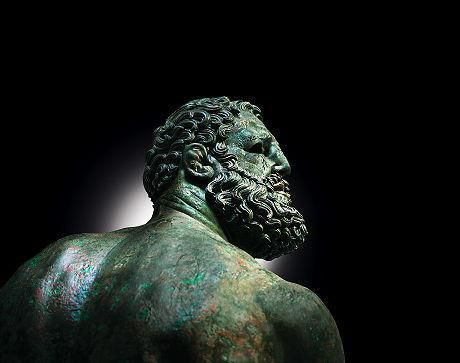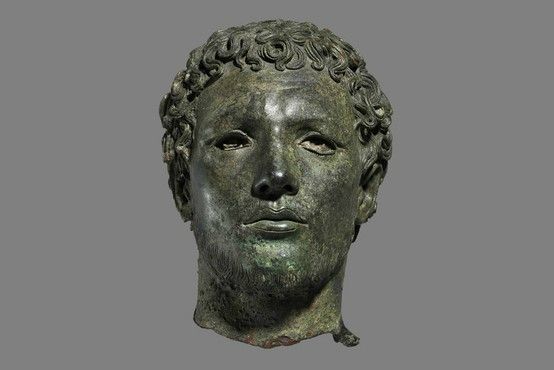Exposition Back to Classic à la Liebighaus, Francfort
Le Boxeur du Quirinal (fin du IVe siècle ou début du IIIe siècle av. J.-C., Museo Nazionale Romano, Rome). Photo akg-images/Jürgen Raible
FRANCFOTT - From 8 February to 26 May 2013, the Liebieghaus Skulpturensammlung will shed new light on ancient Greece in an extensive exhibition entitled "Back to Classic”. Featuring some eighty outstanding works – bronze sculptures, vases, paintings, terracottas and painted figural vessels – this large-scale exhibition and research project will provide a new means of access to the history of the art and culture of Greek Classicism in the fifth and fourth century BC. Along with reconstructions developed especially for the show, these objects will demonstrate the tremendous innovative impetus underlying the aesthetic and intellectual developments of that age. Greek Classicism is regarded as the foundation of the values and culture shared by the countries of Europe, and as such has continued to have an extraordinary impact on European culture to this day. Yet our perception of that epoch, which waxed and waned more than 2,500 years ago, is strongly limited and often manipulated. On the one hand, a significant portion of the original works of art and writing has been irretrievably lost; on the other hand, Roman copies and various phases of neo-classicist reception often distort our view of what has survived. In the Frankfurt exhibition, original masterworks of Greek bronze sculpture and painting – among them spectacular new finds from Porticello and Brindisi – will offer a different, unadulterated picture of classical art. In addition to a large number of loans from collections as far-flung as Berlin, London, New York, Paris, Rome and St Petersburg, the reconstruction of a Riace warrior and the hunting fresco of Vergina – developed on the basis of the latest scientific and technological insights – will bring the original appearance of world-famous masterpieces back to life. A comprehensive catalogue offering a nuanced overview of current scientific and scholarly findings on Greek Classicism will accompany the show.
The conception of the exhibition curated by Vinzenz Brinkmann was accompanied by a carefully chosen scientific committee whose members are Salvatore Settis, former director of the Scuola Normale Superiore di Pisa, Hans-Joachim Gehrke, former president of the Deutsches Archäologisches Institut, Oliver Primavesi, Leibniz Prize recipient and rediscoverer of the philosophy of the fifth century BC, Claudio Parisi Presicce, director of the Capitoline Museums, and Wulf Raeck, excavator of Classical Priene. Along with their pupils, these scholars have all carried out significant research work in the fields addressed by the exhibition project. In their contributions to the comprehensive exhibition catalogue, they will present their latest scientific findings in the areas of archaeology, ancient history and classical philology.
The Greek art of the so-called Classical period developed an entirely new image of the human being. Particularly the first fifty years of this era can be considered exceptionally avant-gardist – so much so that in antique literature a term was coined especially for the relatively brief timespan between the end of the Persian wars (480/79 BC) and the outbreak of the Peloponnesian War (431 BC): the "Pentecontaetia”. Within just a few generations, the painters and sculptors of the epoch arrived at an entirely new perspective on the human being. The mirroring of terrestrial conflicts and lifeworld complexities in the sphere of the gods likewise assumed permanent form during that time. The human being was visualized in a degree of differentiation and intellectual dialectic never attained again. For the first time in the history of mankind, the viewer’s gaze and state of mind were taken completely captive. Sculptors created figures that moved freely in space; painters developed the entire gamut of illusionistic devices. This level of sophistication and inner tension would not be reached again until the Italian Renaissance.
The present-day conception of fifth-century Classical Greece has been distorted by various stages and phases of interpretation and the supposed adoption of the "classical”: the cultural propaganda struggle of the Periclean age, but also the numerous selections – some of them disastrous – carried out within the context of classicist currents, adaptations to Christian-ethical or bourgeois-moral ideals and countless copies have all served to distort the image of classicism. A particularly tragic aspect here is the colossal loss of original Classical works through natural decay and deliberate destruction alike. The recovery of original bronze sculptures of unprecedented beauty and formal force from the oceans over the past forty years has truly emancipated us from this view of the fifth as well as the fourth century BC. Works such as the Portrait of a Philosopher from Southern Italy or the Head of an African Man from Cyrenaica, both to be presented in the show, will convey an impression of the mastery characteristic of "true” or "genuine” classicism. The aim of the Frankfurt exhibition is to liberate classicism from its interpretations and ambiguities and thus to provide access to the "other” classicism in its overall context. In addition to providing fundamental insights into the style and impact of original Classical Greek bronze sculpture and painting, the presentation will also seek to shed light on ideologically and aesthetically oriented perspectives, and thus contribute to creating an understanding of the Classical age that does justice to that culture in all its many testimonies and expressions.
The exhibition structure is based on two central aspects. Taking the present as the point of departure, in the first section the visitor will be introduced to the wide range of classicisms, proceeding backward in time to the fourth and fifth centuries BC – the actual core of classicism. This section will be designed as a walk-in wall newspaper with texts, pictures and quotations, and structured by objects and artworks of the various epochs.
The second thematic complex will revolve around the presentation of spectacular new finds enabling visitors to experience the expressive power of original Classical works first hand. Here the focus will be directed primarily towards original Greek bronze sculpture in its exceptional formal and narrative diversity. Among the objects on view in this context will be such highlights as the Boxer of Quirinal and the bronze Capitoline Horse from Rome. The marble sculptures, particularly the post-Classical antique copies, will be shown in a spatially separate section of the show, where visitors can gain an impression of initial steps in the gradual departure from the originals. The famous Apollo Sauroctonos will serve as an especially telling example of that process.
In addition to Greek bronze sculpture, the exhibition will endeavour to convey the uniqueness of Classical painting. Over the past four decades, numerous wall paintings have been discovered in Macedonian tombs, granting us an unclouded view of original Greek painting. In this connection, a precise restorative reconstruction of a hunting frieze from the façade of the so-called Tomb of Philip II in Vergina (ca. 320 BC) has been carried out in cooperation with Greek scholars of Aristotle University in Thessaloniki. Along with superb paintings on large-scale funerary vessels likewise to be presented in the show, the hunting frieze will provide impressive testimony to the artistic and intellectual sophistication attained by the ancient Greeks in painting – the artistic medium most highly appreciated in their time.
Since the discovery of the Riace bronzes in 1972 off the coast of Calabria, several broadly based technical-scientific investigations have been carried out, yielding remarkable insights into antique working methods. These findings were taken into account in the Liebieghaus’s elaborate reconstructions, which represent an important aspect of the exhibition concept in the area of bronze sculpture as well. During the preliminary stages of the preparations for the show, an authentic cast of the head of a warrior was made within the context of a scientific experiment on the complex technique of bronze casting practised in antiquity. The reconstruction of the famous statue of the Riace Warrior A (460–450 BC, Museo Archeologico Nazionale di Reggio Calabria) conveys the original appearance of this large-scale bronze as vividly as it does the technical aspects of its production. Carried out by Edilberto Formigle, a specialist in ancient Greek bronze technology, this archaeological experiment also encompasses the supplementation of the missing inlay elements such as the warrior’s eyes and teeth, as well as the recovery of the artificial patina.
The exhibition will be accompanied by an extensive catalogue. Publisher: Hirmer Verlag, editor: Vinzenz Brinkmann, articles by E. Formigli, H.-J. Gehrke, C. Parisi Presicce, O. Primavesi, W. Raeck, S. Settis and A. Stewart. German edition, approx. 380 pages, approx. 550 illustrations, 39.80 euros (museum edition)
Exposition Back to Classic à la Liebighaus, Francfort
The exhibition and research project provides a new means of access to the history of the art and culture of Greek Classicism in the fifth and fourth century BC.
Statue of a horse from an equestrian group, found in Rome (Trastevere), 5th century B.C. Bronze, Height 200 cm. Musei Capitolini, Rome© Zeno Colantoni.
DRESDEN.- The Liebieghaus Skulpturensammlung is shedding new light on ancient Greece in an extensive exhibition entitled Back to Classic. Featuring some eighty outstanding works – bronze sculptures, vases, paintings, terracottas and painted figural vessels – this large-scale exhibition and research project provides a new means of access to the history of the art and culture of Greek Classicism in the fifth and fourth century BC. The Boxer of Quirinal, so-called Terme Boxer, 2nd half of the 4th century B.C. or 3rd century B.C. Detail. Bronze. Museo Nazionale Romano, Rome.
DRESDEN.- Winged head representing Hypnos, Greek original of the 4th century B.C. or Roman replica of the 1st century B.C. Bronze, Height 21 cm. British Museum, London© The Trustees of the British Museum.
DRESDEN.- Statue of a horse from an equestrian group, found in Rome (Trastevere), 5th century B.C. Bronze, Height 200 cm. Musei Capitolini, Rome© Zeno Colantoni.
DRESDEN.- Head of a bearded man with hairband, in the sea off Porticello, ca. 450 B.C. Bronze. Reggio di Calabria, Museo Archeologico Nazionale. Photo: Norbert Miguletz.
DRESDEN.- Head of a North African, found in Cyrene (Libya), 2nd half of the 4th century B.C. Bronze, Height 30,5 cm. British Museum, London© Trustees of the British Museum.
DRESDEN.- Head of a bearded old man (the so-called Philosopher of Porticello), in the sea off Porticello, ca. 440/430 B.C. Bronze. Reggio di Calabria, Museo Archeologico Nazionale. Photo: Norbert Miguletz.
DRESDEN.- Fractional reconstruction of the Riace Warrior A, Bronze, 460-450 B.C., bronze casting according to a high resolution scan of the original Bronze, coloured stone, copper, silver, asphalt varnish. Photo: Norbert Miguletz© Liebieghaus Skulpturensammlung.
DRESDEN.- Head of Apollo Sauroktonos by Praxiteles, Chigi Collection, Late Hellenistic replica (1st half if the 1st century B.C.) of the bronze original from ca. 350 B.C. Marble. Staatliche Kunstsammlungen, Skulpturensammlung, Dresden. Photo: H.-P. Klut / E. Estel © Staatliche Kunstsammlungen, Skulpturensammlung, Dresden.
DRESDEN.- Head of a woman, 4th/3rd century B.C. - 2nd century BC. Bronze, Height 28,9 cm. Ackland Art Museum, University of North Carolina, Chapel Hill © Collection of the Ackland Art Museum, The University of North Carolina
DRESDEN.- Attic statuette of Papposilenus bearing the infant Dionysus, early 4th century B.C. Terracotta, Height 11,1 cm. Liebieghaus Skulpturensammlung, Frankfurt am Main.

/https%3A%2F%2Fprofilepics.canalblog.com%2Fprofilepics%2F1%2F0%2F100183.jpg)
/https%3A%2F%2Fstorage.canalblog.com%2F03%2F02%2F119589%2F96711876_o.jpg)
/https%3A%2F%2Fstorage.canalblog.com%2F11%2F31%2F119589%2F94773502_o.jpg)
/https%3A%2F%2Fstorage.canalblog.com%2F20%2F83%2F119589%2F94772815_o.jpg)
/https%3A%2F%2Fstorage.canalblog.com%2F26%2F72%2F119589%2F75604929_o.jpg)
/https%3A%2F%2Fstorage.canalblog.com%2F59%2F60%2F119589%2F26458628_o.jpg)
















/image%2F1371349%2F20240406%2Fob_b23648_434058570-1644317966338216-88086167391.jpg)
/image%2F1371349%2F20240403%2Fob_6d5ae7_dp-28103-001.jpg)
/image%2F1371349%2F20240229%2Fob_8f31f9_431013694-1625286614908018-33034430839.jpg)
/http%3A%2F%2Fstorage.canalblog.com%2F79%2F20%2F119589%2F129837997_o.jpg)